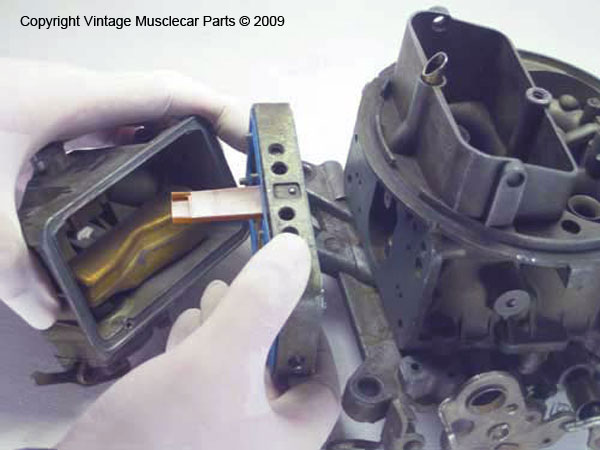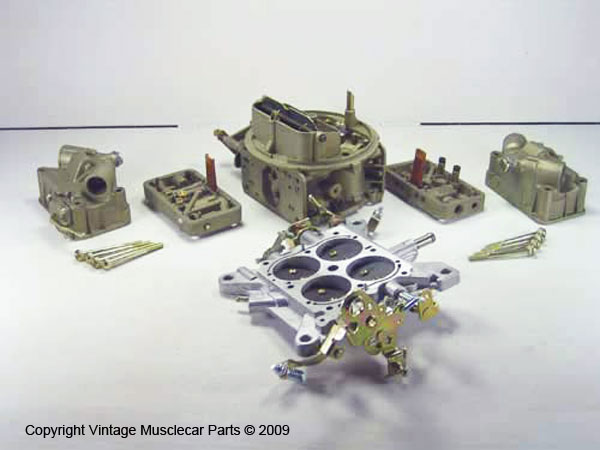
The following is a basic walk-through to give you a general idea of what goes into a typical carburetor restoration. Some of the steps involved won’t be shown simply due to space constraints, and because certain steps & processes are proprietary.
In this instance, the subject is a garden variety Holley 750 cfm double pumper LIST #4779. Below is the core as it arrived to me.
The next step was to dis-assemble the carburetor. Pretty straightforward stuff, not much to show here.


After the carburetor was completely dis-assembled and cleaned, the mating surfaces of the main body were re-surfaced. The picture shows the rear metering block surface after a light cut to highlight how much warp was present. This one wasn’t too bad. The main body gets resurfaced on both metering block surfaces as well as the throttle body surface. The throttle body is also resurfaced on both sides.
One other common source of pesky fuel leaks on Holley carbs is a warped pump cover. Again, this is just after a light cut to highlight the amount of warp present.


Once the throttle body has been cleaned and re-surfaced, the throttle shaft bores are inspected for wear with a “go/no go” gauge. If they are found to be worn, the baseplate is bored out and oversize bronze bushings are driven in and reamed to size.
One step many rebuilders skip is removing the well plugs and/or emulsion tubes from the metering blocks before cleaning. I remove them on every Holley I build, whether it’s a full restoration or just a basic rebuild. You simply can NOT get the metering block 100{e8a31ad70eb76b9d1736af28c4c10c5ce60babf18dd7728d2fa05ac44ba5f2cd} clean without removing these components!


Some other common issues with Holley carbs are stripped needle & seat threads and stripped fuel inlet threads. In most instances these can be repaired with threaded inserts.
My process for repairing stripped inlet threads is proprietary, so I can’t show the details on how it’s done. Please note that my process ensures the repair threads are cut exactly on plane with the original threads which eliminates the need to use those thick white Teflon washers that other builders use to compensate for thread mis-alignment. Note the Quadrajet pics below for more.


Original style fuel inlet gasket. Compare this to the thick white Teflon gasket shown in the pics below–which is pretty unsightly on a concourse restored carb.








You have to look closely to spot this one; this metering block came from another carburetor that had been rebuilt multiple times but always ran very rich at idle. It took a while to find this, but upon close inspection,I spotted what I thought to be some porosity on the primary metering block. When the block was stripped, the issue became quite clear–there was a severe void covered by a thin “skin” of flashing that went from the float bowl side of the metering block directly into one of the idle well passages. No wonder it always idled rich! The metering block was replaced and the problem was solved!


Another frequent problem on Holleys is a cracked base plate. On the OE musclecar carbs, more often than not it’s the right front corner that’s cracked. As long as the broken section is still with the base, I can usually repair them. Again, my process for this is proprietary so I can’t show how it’s done. Most other builders will have the base welded which results in an unsightly weld blob on the corner of the base. My process only leaves a faint visible line where the break was.
Once everything has been reconditioned, everything gets stripped back down to bare metal in preparation for the re-coloring process. All of the zinc castings are re-colored back to their original appearance using the proper chemicals.
I can’t show the actual re-coloring process for obvious reasons. However, here is a picture of all the major components stripped and ready to be re-colored.

Once all the components have been re-colored, the sub-assemblies go together with the appropriate new and/or reconditioned parts. No generic parts here!


Once all the sub-assemblies are completed, the carburetor goes back together. Everything is checked for proper fit and operation, and all the basic adjustments are performed.


And there you have it. While I used a HOLLEY carburetor for illustrative purposes, the same basic principals and processes apply to most other carburetor makes & models.
If you have any questions or if you’re interested in having us service your carburetor, please feel free to send an email or give us a call!

